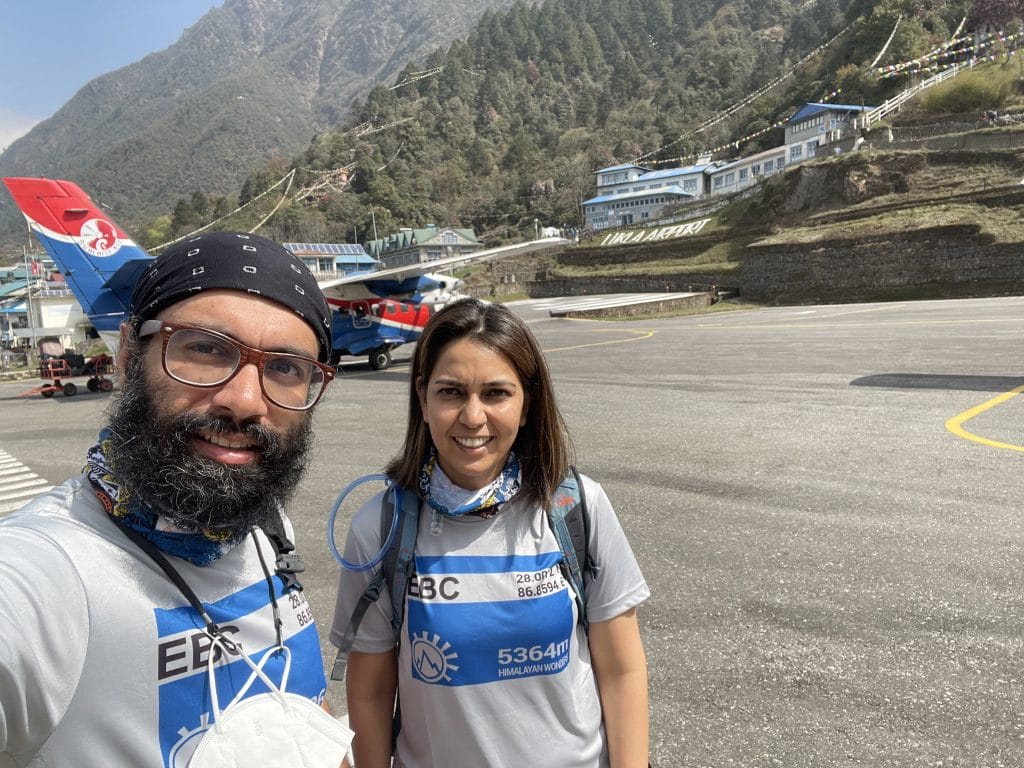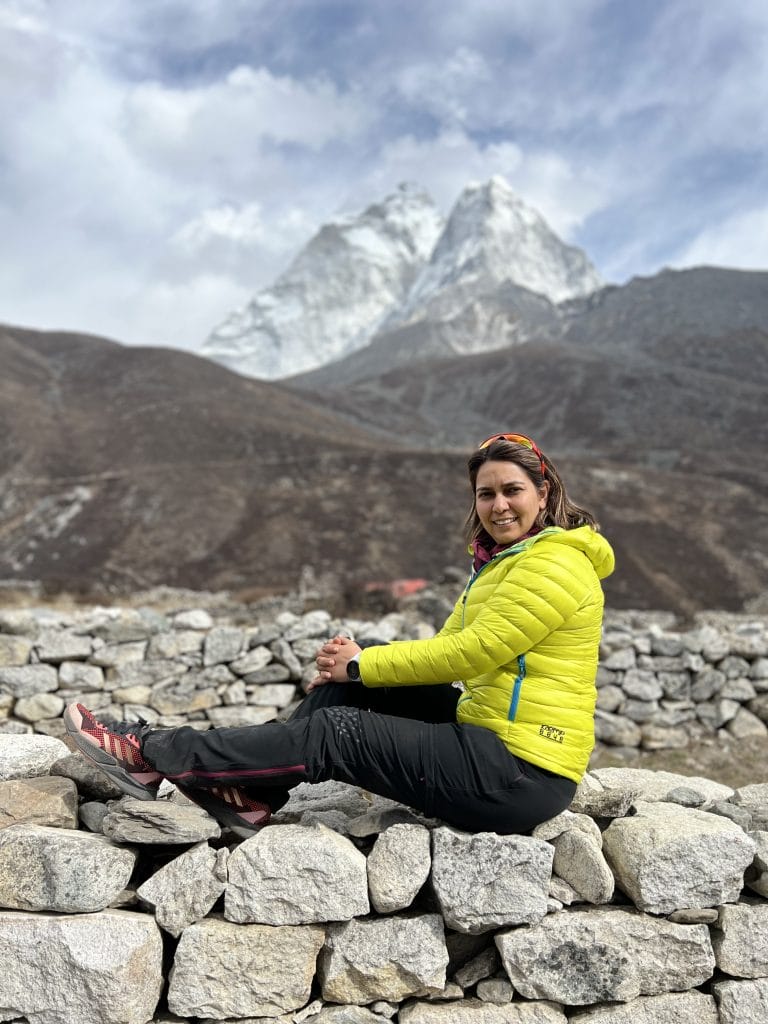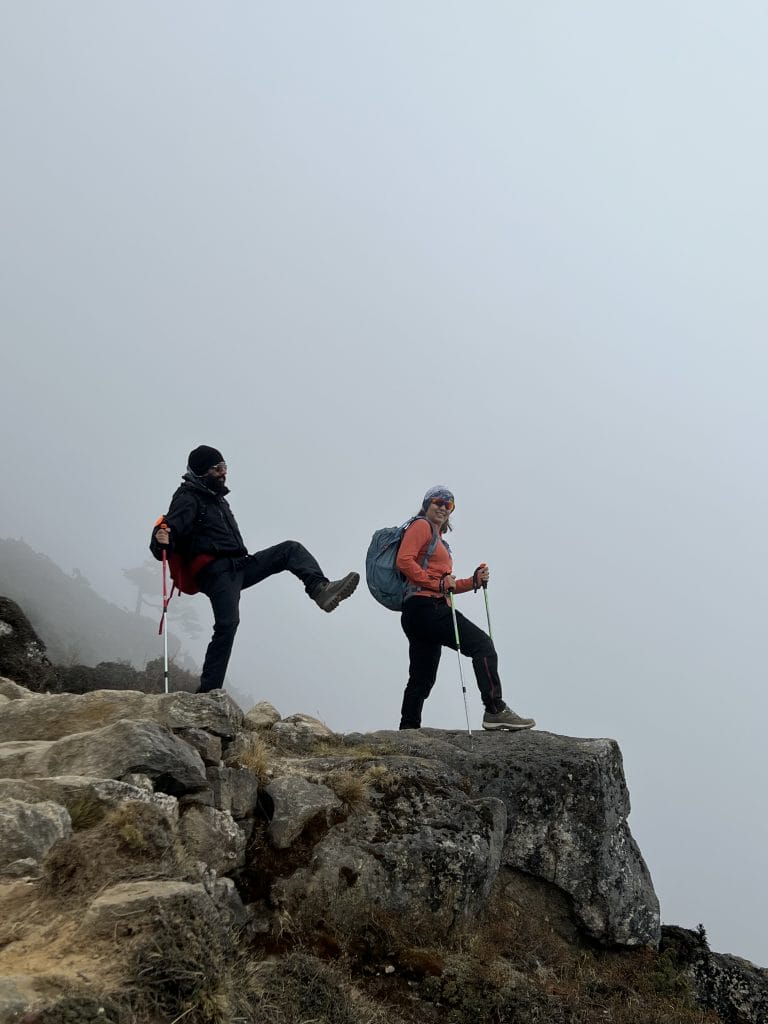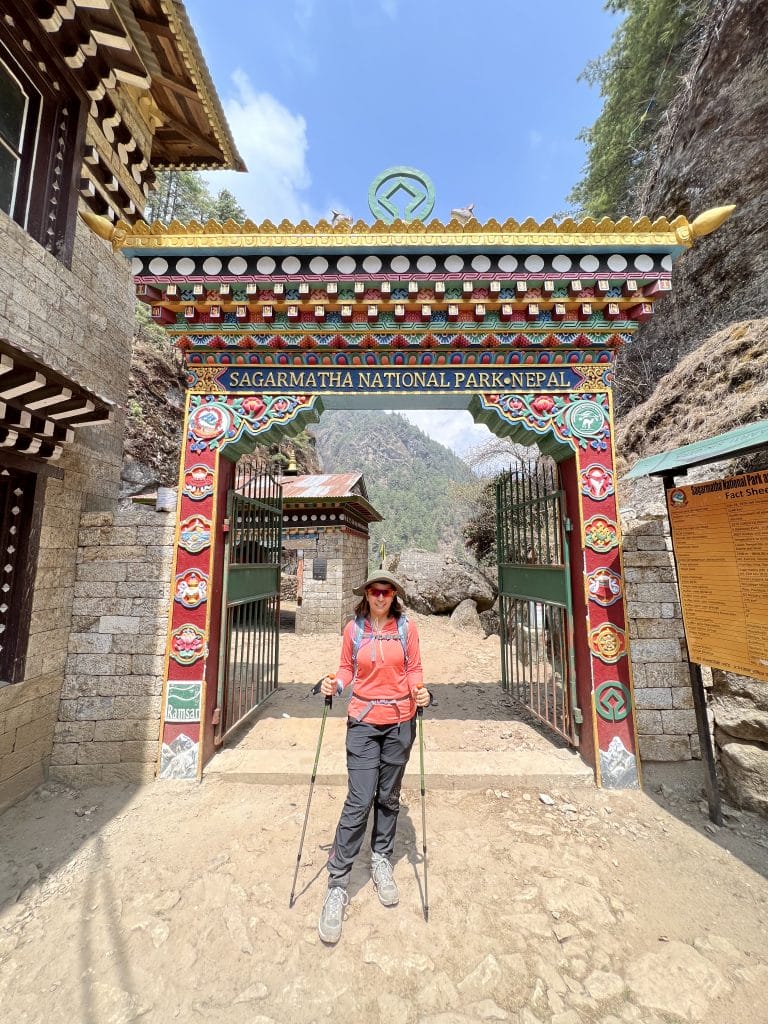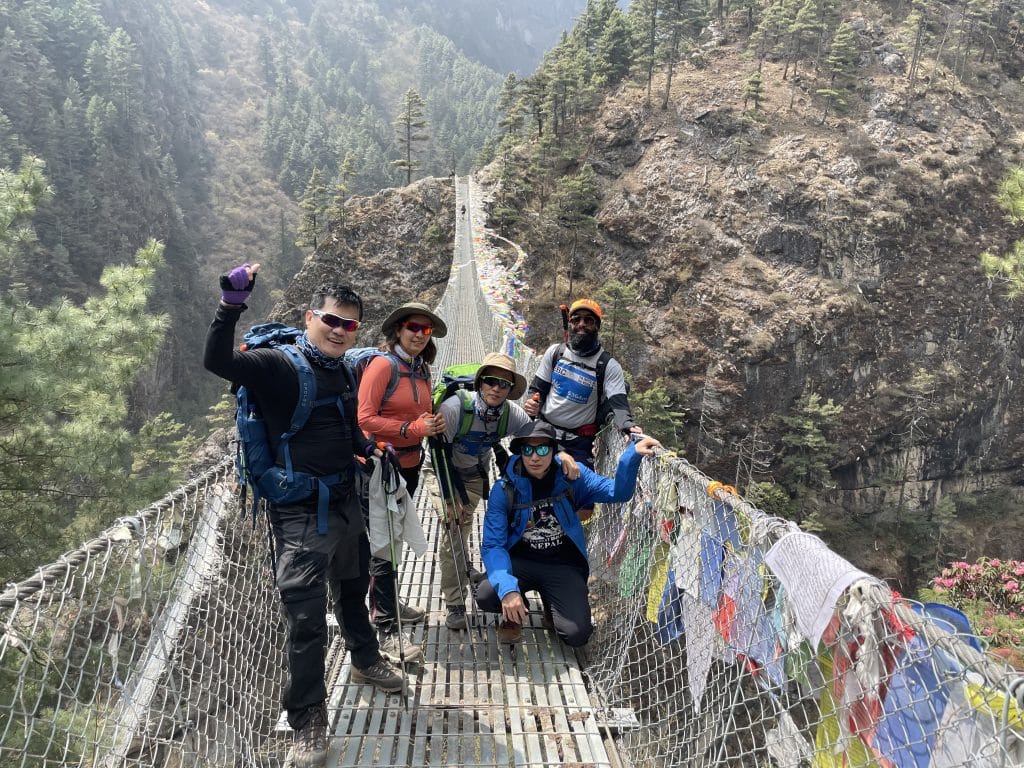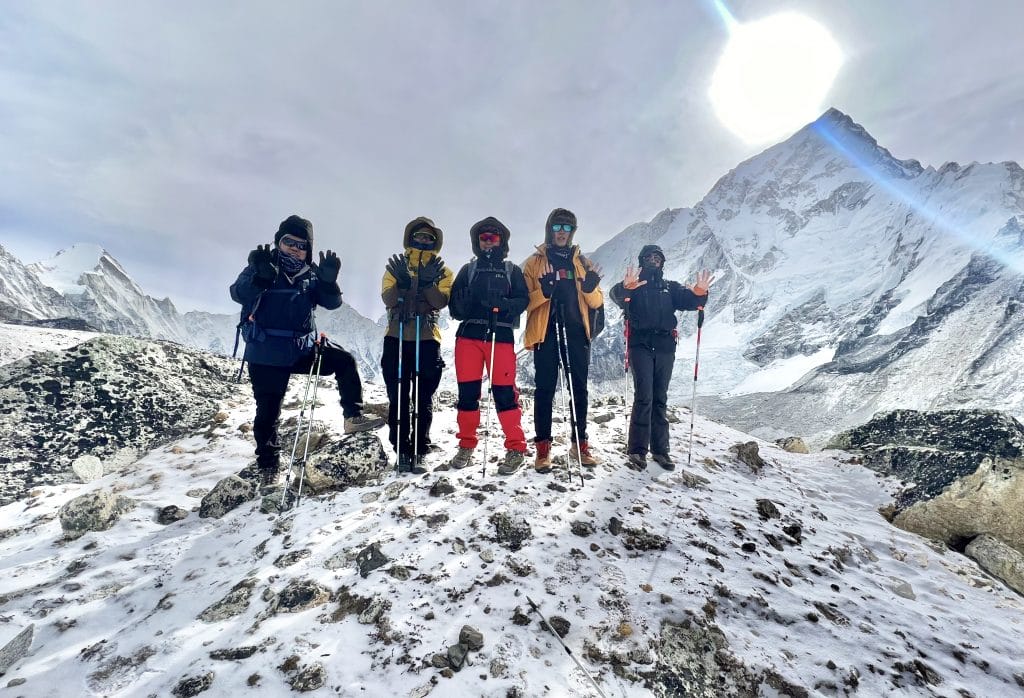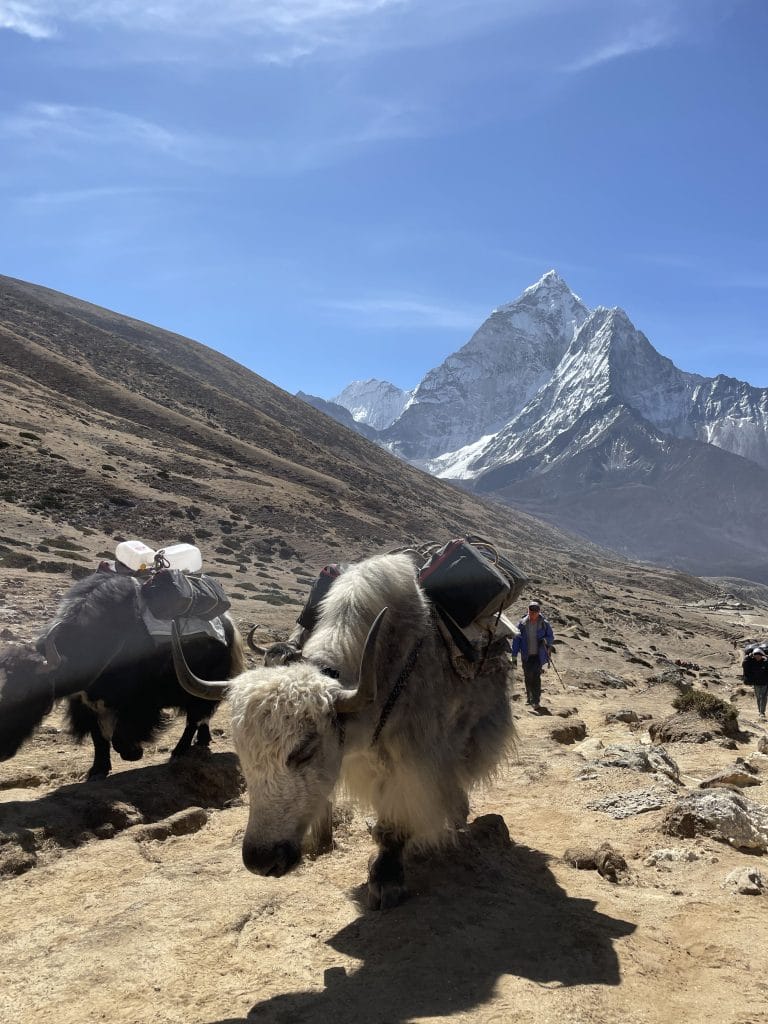Plus travel tips for those who want to visit the bottom of the top of the world.
Mount Everest is the highest mountain on earth at 8,848m above sea level, and can be accessed from two countries, Nepal and Tibet. It’s a destination on many people’s bucket list, with hundreds of thousands of people dreaming to go each year, but only a fraction of extremely lucky ones make it. Thankfully, I was able to make this dream come to life for me last April, together with another Thai-Indian, Anan Narang.
For novice trekkers like me, getting the closest to the highest peak at Everest Base Camp was my goal. There are actually two: the South Base Camp, which I went to, is in Nepal at an altitude of 5,364m, while the North Base Camp is in Tibet.
This once-in-a-lifetime trek has so much to offer, from the most kind and hospitable people to the beauty of the majestic Himalayan Range. The mountains have a knack for changing people — stripping us of our thoughts, revealing our vulnerability, who we really are, and forcing us to accept our circumstances by adapting and carrying on. No matter the conditions, the mountains remain, welcoming everyone with open arms and without judgment or prejudice, and no artificial societal pressures. They remind us of what we are capable of as humans, both physically and mentally, and not to under estimate our own strength and willpower. At the same time, it shows us the power of nature, where we little humans cannot predict anything, and though we can plan for the best, we still need to be prepared for the worst.
Through this trip, I realised that reconnecting to Mother Nature is the only way to remind ourselves to take that break, look back, and be grateful that there is so much more to life that what is ingrained in our society. In our world of comfort, we forget to value small things — clean water, hot showers, hot meals, even access to toilets. This trek gave me an experience that will remain with me forever; a feeling of high on the highest mountain in the world. To quote Sir Edmund Hillary, “It is not the mountain we conquer, but ourselves.”
Though I would have loved to do this trek with my sister, she was busy creating her own kind of magic. I thought of her every day, every moment, and hope that I get to go back to the mighty Everest with her someday soon. For others who are interested in embarking on this life-changing experience for themselves, I’ve written up my journey to inspire you, with some tricks and tips:
HOW TO GET TO EBC, NEPAL
The trek to EBC starts from Lukla, and there are two ways to get there:
Option one: Drive from Kathmandu to Jiri, and embark on a three-day trek to Lukla.
Option two: Fly either by plane or helicopter. It is normal for flights to be delayed, and even cancelled for days at a time. Our flight (Summit Air) was delayed by over two hours.
It is recommended to have a guide just to make things easier, but if you are more adventurous, you can plan the entire trek on your own, and since the sign boards are clear and the paths are well trodden, there is a low chance that you’ll get lost. We had Himalayan Wonders help us plan our trek, and they were exceptional. They took care of all our accommodation at every tea house, and provided three meals a day.
OUR DAILY ROUTINE FOR 14 DAYS
- 6am: Wake up, pack, freshen up, and have breakfast at the dining area at 7am
- 8am: Start walking, stop for a tea break after two hours
(or not) - Noon: Lunch at another tea house
- Trek for another 6-8 hours a day until we reach the destinationtea house
- Unpack, clean up, and hang out in the dining area where the heating is turned on.
ACCOMMODATION
The rooms at the tea houses are clean and basic, with twin beds lined with sheets, a pillow, and a duvet of sorts. There is no heating or plug points in the rooms, and often no mirror either, just some hooks to hang dirty clothes.
CHALLENGES
The trail itself is quite straightforward, but the trek is difficult. For those with decent fitness levels, you’ll be physically fine, but the altitude makes it a whole different story. One of the most dangerous things about hiking in high altitude is the risk of getting Acute Mountain Sickness (AMS), caused by rapid exposure to the low amount of oxygen at that height. AMS does not pick its victims; even the fittest of us all can fall prey to it. The key is to go slow, because that helps with gradual exposure to lower oxygen levels and allow the body time to acclimatise. Tip: Take Diamox tablets as a back-up to help with preventing high altitude sickness.
We had planned our trip from Lukla to EBC to Gokyo (via Chola Pass), and then a circuit back to Lukla. On our EBC day, I started to feel out of breath, low on energy, and very sleepy with a blasting headache. My goal to reach EBC and my excitement kept me going, but the three-hour walk from Gorakshep to EBC became even more difficult. After a night’s sleep in Gorakshep, I had to make the difficult decision of skipping the gorgeous Gokyo and missing out on the notorious Chola Pass, and made my way down with the porter.
ITINERARY
Day 1: Kathmandu to Lukla (2,800m) to Phakding (2,652m)
Day 2: Phakding (2,652m) to Namche Bazaar (3,440m): crossed five suspension bridges that swung in the high wind. The longest one is called Hillary Bridge. We also walked along the Dudh Koshi (milk) river, and went through checkpoints to enter the Sagarmatha National Park that houses the entire Everest region on the Nepal side.
Day 3: Rest Day at Namche Bazaar: rest days allow our bodies to acclimatise to the high altitudes.
Day 4: Namche Bazaar to Milingo (3,937m)
Day 5: Milingo to Dingboche (4,400m): We started losing vegetation – the trees were gone, and we were left with shrubs. The sun and wind felt stronger, as there were no trees for shade, or windbreakers. I wore my base layer for the first time today. The room temperature water was too cold to drink, so this was another turning point where I started to drink warm water. Since we had gained significant altitude, and the environment was different, our guide started checking our oxygen levels at dinner just to make sure that we were all coping ok with being high in the mountains.
Day 6: Rest Day at Dingboche
Day 7: Dingboche to Lobuche (4,900m): The first few hours of the trek had the most gorgeous 360-degree view whose beauty we tried to capture on camera but it was an impossible feat. After lunch at Thukla, the shrubs turned into mud, then larger rocks. Right after Thukla Pass is the memorial for all those that lost their lives on the mighty Everest, which included Scott Fischer(from the book Into Thin Air: A Personal Account of the Mt. Everest Disaster by Jon Krakauer) and Dr. Eve Girawong from Thailand. The thin air made it tough to keep going, but my legs were ok. By the end of the day, I was tired, and it was so cold that wet wipes were frozen, and I didn’t want to wash my hands, as the only option was cold water.
Day 8: Lobuche to Gorakshep (5,180m) to Everest Base Camp (5,364m): This was a super long walk that looked flat but in reality, it wasn’t. We had a much-required lunch break at Gorakshep where we could sit, breathe, and eat as much as possible. We also quickly changed into warmer clothes that we would need for the final push to the EBC.
Witnessing the Khumbu icefall and parts of glaciers during the last stretch of walk from Gorakshep to EBC was out of the world! Even though it was hard to breathe and walk on the rocks, the feeling of just being there was very rewarding. Upon arrival at EBC, I forgot how thin the air was, how tired I was, and how hard the trek was. As soon as we were done taking photos to mark this milestone accomplishment, it started to snow.
This was by far the coldest day and night on the mountains for me – there was a snowstorm later in the evening. I wore all the clothes that I had (four layers), my toothpaste froze, and there was no washbasin at our tea house so either you wash your hands and brush your teeth in the toilet sink, or simply skip the ritual. It was so cold that even with all my layers, and the sleeping bag, I couldn’t sleep. However, while it was one of the toughest days, it was also the most rewarding one. Knowing that you’ve made it to the (bottom of the) top of the world is such an exhilarating feeling.
Day 9: Gorakshep to Lobuche to Pheriche (4,371m): Nothing went as per plan for me on this day. This was the day that I split ways from my friends because of AMS. As I lost altitude, I started to feel much better. I could drink more water, and eat better too. By the end of the day, I had only one side effect of the high altitude: diarrhoea.
Day 10: Pheriche to Kyangjoma (3,600m): Shrubs became trees, and then trees had flowers. It was such a wonderful feeling to be in beautiful nature with lots of oxygen once again. Other than the diarrhoea that kept me on the lookout for toilets along the way, it was a very peaceful walk, and refreshing to spend time alone in the mountains.
Day 11: Kyangjoma to Namche Bazaar
Day 12: Namche Bazaar: I decided to wait for my friends here, so we could head to Lukla and end the trek together. My heart was jumping with joy to reunite with my friends at the end of the day!
Day 13: Namche Bazaar to Lukla
Day 14: Lukla to Kathmandu: The weather in the mountains and valleys changes very quickly. There are very high chances that flights will get delayed or cancelled, but we were lucky on both sides to make our flights on the day we planned.
FUN FACTS AND TOP TIPS:
• Everest Base Camp is not on Mount Everest. It is in between two mountains that go towards the mighty Everest.
• Sherpas are a Tibetan ethnic group, comprised of generally very strong people who are accustomed to the high altitude.
• The airport at Lukla is called Tenzing-Hillary Airport, named in honour of Sherpa Tenzing Norgay and Sir Edmund Hillary, the first people confirmed to have reached the summit of Mount Everest. It is a 527m long runway, with a gradient of 11.27 percent, which makes it renowned as the “world’s most dangerous airport.”
• Until the EBC, you don’t sleep in tents, you sleep in tea houses which are quite comfortable.
• Sunglasses are a must to protect from dust, wind and glare. Other recommended weather-appropriate gear can be found at the Himalayan Wonders website.
• If you have a porter, they can carry up to 10kgs in a duffle bag for you, and the rest goes in your day pack — the lighter it is, the easier it is on you.
• You can spot several helicopters a day on the Himalayan Range. They are also known as khumbus/mountain taxis, and are used for rescues, sightseeing, and dropping off supplies.
• The ‘go to’ beverage for me was hot ginger lemon honey tea. • Daal Bhaat Power, 24 hour – a local expression to celebrate daal, which the locals eat daily for its slow-release of energy.
• It is recommended to drink three litres of water or more per day, as this helps with managing the dry weather and acclimatising to the altitude as well.
• We share the trail with animals: starting with horses, oxen, and donkeys, then graduating to the super-strong yaks. Yaks are found at high altitudes, in colder weather. Their fur is used to make jackets and other warm clothing, there’s also yak steak for consumption, and their poo is used as coal for the heaters.
• There are lots of prayer bells along the mountain, and we recite “Om mani padme hum,” which means “may there be good luck and happiness.”
• At the EBC, and along the stupas, Tibetan prayer flags brighten the bare mountains, made of colourful rectangular cloth, and often found strung along trails and peaks high in the Himalayas. We got some for our backpacks too.
• Food, water and chocolate get progressively more expensive as we gain altitude, starting at NPR 25 at Kathmandu, up to NPR 400 at Gorakshep. (USD 1 = NPR 120 at the time)
You can read the entire story at https://medium.com/@shveta.kukreja/everest-base-camp-56fd132919dc



